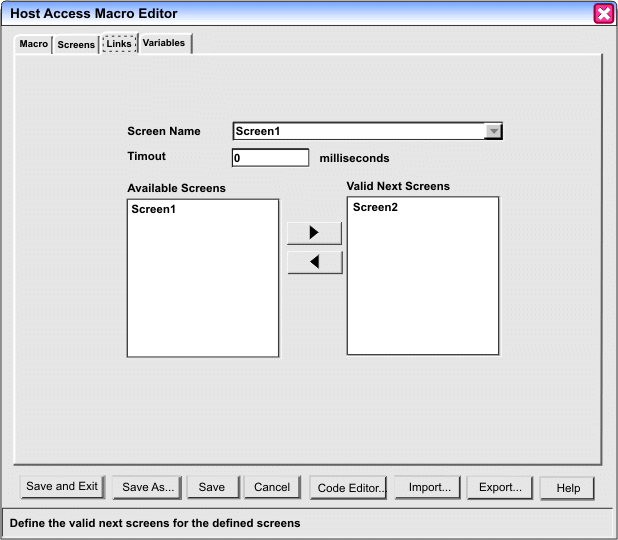Valid next screens
As you may remember from How the macro runtime processes a macro screen, the macro runtime typically finds the names of macro screens that are candidates for becoming the next macro screen to be processed by looking in the <nextscreens> element of the current macro screen. That is, the macro screen contains within itself a list of the macro screens that can validly be processed next. (Entry screens and transient screens are exceptions, see Entry screens, exit screens, and transient screens.)
In the Macro Editor, the Links tab provides the user interface
for storing the names of candidate macro screens into the <nextscreens>
element of a macro screen. Figure 1 show a
sample Links tab:
Figure 1. Sample Links tab
In the figure above, the Screen Name listbox at the top of the
tab contains a list of all the macro screens in the entire macro.
The currently selected macro screen is Screen1. On the right, the
Valid Next Screens listbox contains a list of candidate macro screens
for Screen1 (Do not confuse this listbox, which contains the names
in the <nextscreens> element of Screen1, with the list of valid
next screens that the macro runtime uses when a macro is played back).
On the left, the Available Screens listbox contains a list of the
names of all other macro screens .
Although the figure above shows only one screen in the Available
Screens list, that is because this figure is from a macro with only
two macro screens in it, Screen1 and Screen2. Instead, imagine a macro
of twenty screens, and suppose that you want to add macro screens
to the <nextscreens> list of a new macro screen, ScreenR. You would
follow these steps:
- On the Links tab, expand the Screen Name listbox and scroll down until you find ScreenR.
- Select ScreenR.
- Because ScreenR is a new screen, there are no macro screen names listed in the Valid Next Screens list on the right.
- On the left, the Available Next Screens listbox contains the names of all the macro screens in the macro.
- Select a screen that you want to add to the list for ScreenR. Suppose that you select ScreenS.
- After selecting ScreenS, click the right arrowhead button between the two listboxes. ScreenS is added to the listbox on the right, and removed from the listbox on the left.
- In the same way, move the names of any other macro screens that you want to the Valid Next Screens listbox for ScreenR.
- Suppose that you move a total of three screen names: ScreenS, ScreenG, and ScreenY.
In the Code Editor, you would see the names of the valid next macro
screens, ScreenS, ScreenG, ScreenY, stored inside ScreenR as shown
in Figure 2:
Figure 2. Macro screen ScreenR with <nextscreens>
element
The figure above shows the <screen> element for ScreenR,
with the name attribute set to "ScreenR".
Inside are the three primary structural elements of a <screen>
element: the <description> element, the <actions> element, and
the <nextscreens> element. The contents of the <description>
element and the <actions> element are not shown but are indicated
with an ellipsis (...). The <nextscreens> element contains three <nextscreen>
elements, and each <nextscreen> element contains the name of one
of the valid next screens: ScreenS, ScreenG,
and ScreenY.<screen name="ScreenR" entryscreen="true" exitscreen="false" transient="false">
<description>
...
</description>
<actions>
...
</actions>
<nextscreens>
<nextscreen name="ScreenS"/>
<nextscreen name="ScreenG"/>
<nextscreen name="ScreenY"/>
</nextscreens>
</screen>For more information about runtime processing see How the macro runtime processes a macro screen.